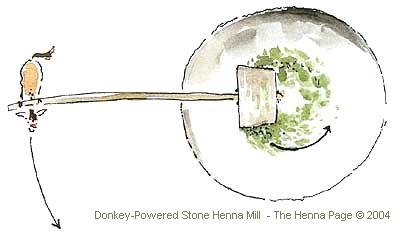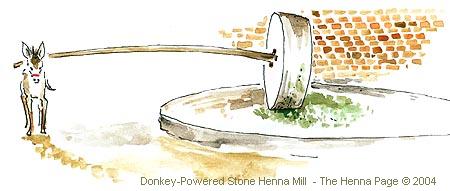|
Catherine Cartwright-Jones © 2004  Henna
leaves canot be used whole for hair or skin dye, they must be crushed
to make the Lawsone dye accessible. Some love poetry compares
grinding henna for beautiful red stains to enduring the stresses in
relationships to bring about deeper love.
The above illustration shows the operation of an old style henna mill in Yazd, Iran, as it is used to grind henna leaves into henna powder. This kind of mill has been used to process henna and other products in many countries. Such mill stones are limestone, and must be tended by a "dresser" who cuts grooves into the stone surface to facilitate grinding. These limestone mills always leave a small amount of limestone powder in the milled product. Limestone is alkaline, a compound of carbon, calcium and oxygen. When it comes in contact with acid, such as the lemon juice mixed with henna, the carbon and oxygen are released as carbon dioxide, the same gas that makes the "fizz" in carbonated drinks. Henna ground on limestone mill wheels will "puff up" or "bubble" slightly when lemon juice is added, because of the carbon dioxide gas released by the acid/alkali reaction.  The millstone is driven by a donkey and attendant who walk slowly around the grinding wheel, slowly grinding and rotating over the henna leaves. Another person adds dried henna leaves to the milling heap, then gathers powder when it is finely ground. This older style mill, grinding slowly, does not heat up the henna during the milling process as would modern high-speed mills, and so preserves the henna's dye quality. In Medieval Spain, before henna was outlawed
in the 16th century, henna was a cultivated crop in the southern
regions, and there were many water powered henna mills, arha'al-hinna, west of
Cordoba, at Munyat Nasr, and other areas down the Quadalquivir River.
These vertical henna mills alternated with other mills, because
Andalusi engineers placed overshot and undershot mills in sequence
along rivers, maximizing the efficiency of the water's power. Glick, T. 1979 Islamic and Christian Spain in the Early Middle Ages Princeton University Press More Web Resources on Milling Dressing
of Millstones
http://scholar.lib.vt.edu/mirrors/vaes/99-1-4.pdf Vertical Water Mill http://www.angelfire.com/journal/pondlilymill/graphics.html For related articles on cultivating and
using fresh henna, see:
Back to the Index of
The
Encyclopedia of Henna
Can't find what you're looking for? Try: The Henna Page Main Index http://www.hennapage.com/henna/mainindex.html *"Henna,
the
Joyous Body Art"
the Encyclopedia of
Henna
Catherine Cartwright-Jones c 2000 registered with the US Library of Congress TXu 952-968 |